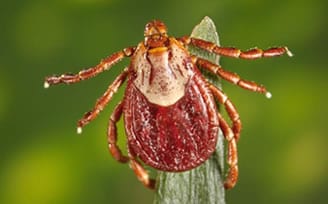Message Mapping Guide Helps Modernize Case Surveillance for Tickborne Rickettsial Diseases

To improve accuracy and reduce burden of using case report forms for tickborne rickettsial disease (TBRD) surveillance, CDC rickettsial disease experts in the Division of Vector-Borne Diseases collaborated with the CDC Division of Health Informatics and Surveillance, jurisdictions, and other partners to develop and implement a new message mapping guide (MMG) for Lyme disease and TBRD.
By facilitating use of streamlined, interoperable data standards and vocabulary for TBRD case notifications, the new MMG makes it faster and easier for jurisdictions to send high-quality TRBD case notification data to CDC, providing CDC with more complete and timely data.
At this time, several jurisdictions are using the new Lyme disease and TBRD MMG to send case notification data to CDC. It will be critical for continued modernization of Lyme disease and TBRD data in support of the CDC Data Modernization Initiative for more jurisdictions to begin using the new MMG to send data to CDC. Use of the Lyme disease and TBRD MMG will provide timely information to help identify and understand the burden of rickettsial disease and emerging trends.
Full Story
Public health problem
Tickborne diseases are on the rise in the United States, including tickborne rickettsial diseases (TBRD) such as Rocky Mountain spotted fever, anaplasmosis, and ehrlichiosis. Jurisdictions send data about national notifiable TBRD to CDC using the National Notifiable Diseases Surveillance System (NNDSS), managed by CDC’s Division of Health Informatics and Surveillance (DHIS). TBRD experts in CDC’s Division of Vector-Borne Diseases (DVBD) then use these data to analyze and identify emerging disease trends.
Basic case notifications submitted to NNDSS include limited information on demographics and disease classification. This means that CDC’s TBRD experts can’t get the full picture they need to effectively analyze TBRD transmission patterns and risk factors across the country. In addition to the basic case notification, most jurisdictions traditionally submit supplemental TBRD case data to CDC using case report forms. These forms include critical information about diagnostic testing, clinical outcomes, and risk factors for exposure. Case report forms are submitted using fax or email, requiring significant manual work to complete, submit, process, and analyze the data. Jurisdictions must often submit their data twice to form a complete epidemiological picture, once through the NNDSS-based system, and a second time using the case report form, creating an unnecessary burden on the health departments. While basic data are available through NNDSS within a year, TBRD case report form data can be delayed years, reducing CDC’s ability to quickly identify emerging disease trends.
Actions Taken
To help address the limitations of TBRD surveillance and reduce the burden on jurisdictions, DVBD’s rickettsial disease experts collaborated with DHIS’s NNDSS team, jurisdictions, and other partners to develop and implement a new message mapping guide (MMG) for Lyme disease and TBRD.
MMGs used in NNDSS case-based surveillance describe the data content needed for electronic case notifications. They are a critical part of modernizing case-based surveillance for over 120 national notifiable diseases and conditions, including TBRD.
By facilitating use of streamlined, interoperable data transmission standards and vocabulary for TBRD case notifications, the new MMG makes it faster and easier for jurisdictions to send high-quality TBRD case data on the full range of questions from the case report form to CDC. This provides TBRD disease experts with more complete and timely data.
Outcome
Tick ranges are expanding; new areas are at risk for potentially dangerous tickborne diseases. While old reporting practices led to delays in recognizing and reporting emerging trends, the new Lyme disease and TBRD MMG allows CDC to use NNDSS for more timely analysis of disease data, communication with public health partners, and enhanced prevention efforts. The team plans to share findings from the latest TBRD surveillance data with jurisdictions and partners in upcoming surveillance summaries.
At this time, a few jurisdictions are using the new Lyme disease and TBRD MMG to send case notification data to CDC. CDC is working to increase jurisdiction adoption of the new MMG, which is critical for modernization of Lyme disease and TBRD surveillance in support of the CDC Data Modernization Initiative.
Learn about how the new MMG is also modernizing surveillance for Lyme disease.